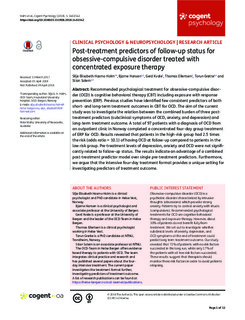| dc.contributor.author | Holm, Silje Elisabeth Hasmo | |
| dc.contributor.author | Hansen, Bjarne | |
| dc.contributor.author | Kvale, Gerd | |
| dc.contributor.author | Eilertsen, Thomas | |
| dc.contributor.author | Grøtte, Torun | |
| dc.contributor.author | Solem, Stian | |
| dc.date.accessioned | 2018-09-10T13:38:53Z | |
| dc.date.available | 2018-09-10T13:38:53Z | |
| dc.date.created | 2018-04-18T09:46:17Z | |
| dc.date.issued | 2018 | |
| dc.identifier.citation | Cogent Psychology. 2018, 5:1461542 1-12. | nb_NO |
| dc.identifier.issn | 2331-1908 | |
| dc.identifier.uri | http://hdl.handle.net/11250/2561809 | |
| dc.description.abstract | Recommended psychological treatment for obsessive-compulsive disorder (OCD) is cognitive behavioral therapy (CBT) including exposure with response prevention (ERP). Previous studies have identified few consistent predictors of both short- and long-term treatment outcomes in CBT for OCD. The aim of the current study was to investigate the relation between the combined burden of three post-treatment predictors (subclinical symptoms of OCD, anxiety, and depression) and long-term treatment outcome. A total of 97 patients with a diagnosis of OCD from an outpatient clinic in Norway completed a concentrated four-day group treatment of ERP for OCD. Results revealed that patients in the high-risk group had 2.5 times the risk (odds ratio = 10.1) of having OCD at follow-up compared to patients in the low risk group. Pre-treatment levels of depression, anxiety and OCD were not significantly related to follow-up status. The results indicate an advantage of a combined post-treatment predictor model over single pre-treatment predictors. Furthermore, we argue that the intensive four-day treatment format provides a unique setting for investigating predictors of treatment outcome. | nb_NO |
| dc.language.iso | eng | nb_NO |
| dc.publisher | Cogent OA | nb_NO |
| dc.rights | Navngivelse 4.0 Internasjonal | * |
| dc.rights.uri | http://creativecommons.org/licenses/by/4.0/deed.no | * |
| dc.title | Post-treatment predictors of follow-up status for obsessive-compulsive disorder treated with concentrated exposure therapy | nb_NO |
| dc.type | Journal article | nb_NO |
| dc.type | Peer reviewed | nb_NO |
| dc.description.version | publishedVersion | nb_NO |
| dc.source.pagenumber | 1-12 | nb_NO |
| dc.source.volume | 5:1461542 | nb_NO |
| dc.source.journal | Cogent Psychology | nb_NO |
| dc.identifier.doi | 10.1080/23311908.2018.1461542 | |
| dc.identifier.cristin | 1579985 | |
| dc.description.localcode | © 2018 The Author(s). This open access article is distributed under a Creative Commons Attribution (CC-BY) 4.0 license. | nb_NO |
| cristin.unitcode | 194,67,40,0 | |
| cristin.unitname | Institutt for psykologi | |
| cristin.ispublished | true | |
| cristin.fulltext | original | |
| cristin.qualitycode | 1 | |

